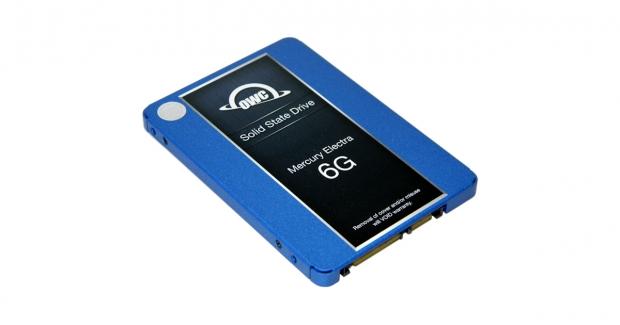The Bottom Line
Introduction, Drive Specifications, Pricing and Availability
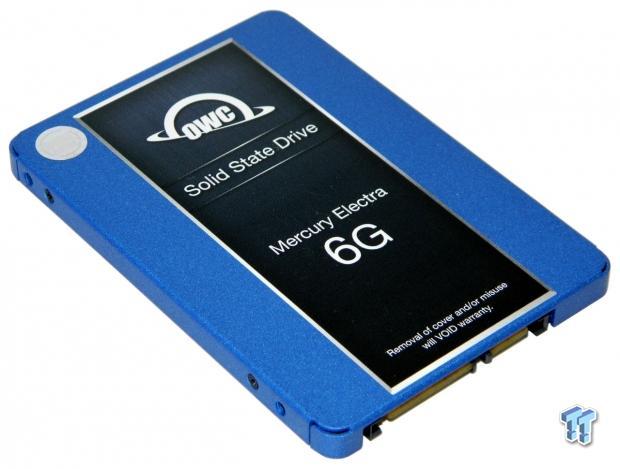
Other World Computing (OWC) has been providing quality hardware products and support to the computer industry since 1988. OWC is THE go to e-commerce portal for upgrading, enhancing, or purchasing Apple products. OWC caters to media creation professionals, which is a niche area where Mac's have a substantial presence. OWC storage products are designed and assembled in the USA. OWC is very proud that their Woodstock, IL corporate headquarters is the first technology manufacturer/distributor site in the U.S. to become 100% on-site wind powered.
As resolutions have increased to 1080p and now 4K content, the need for ultra-high performance, high capacity storage is hitting a fever pitch. Samsung was first to respond to this need with their 2TB 850 Pro and EVO SATA III SSDs. Now, OWC is looking to tap into this market by catering to Mac-based media professionals and everyday Mac users who are looking for more capacity from an SSD that is built by an Apple certified developer.
OWC states that their Mercury Electra MAX 6G 2TB is designed for Mac first. The Mercury Electra MAX 6G 2TB SSD undergoes OWC's rigorous 7-Stage testing procedure including 100% burn-in testing to assure dependability. Just to be clear; OWC SSDs are Mac first, but they are also fully PC compatible.
While at CES earlier this year, we caught a glimpse of an interesting prototype drive configuration. This design featured dual SM2246EN controllers bridged by a RAID controller chip to create a 2TB 2.5"x7mm SATA III SSD. This design was one of those that had us asking ourselves, "WHY?" Why would anyone pursue this path to more capacity?
This configuration didn't offer any performance advantage; in fact, the numbers we saw displayed a performance disadvantage in comparison a standard SM2246EN controlled SSD. Also, the onboard RAID controller likely meant there would be no TRIM support. As we see it, if you are giving up a significant amount of performance and TRIM support for capacity, then that additional capacity is not worth it.
Today, we are going to get a chance to see firsthand if our initial thoughts on a dual controlled SM2246EN SSD were correct or not, because the OWC Mercury Electra MAX 6G 2TB SSD turns out to be a similar configuration.
Specifications
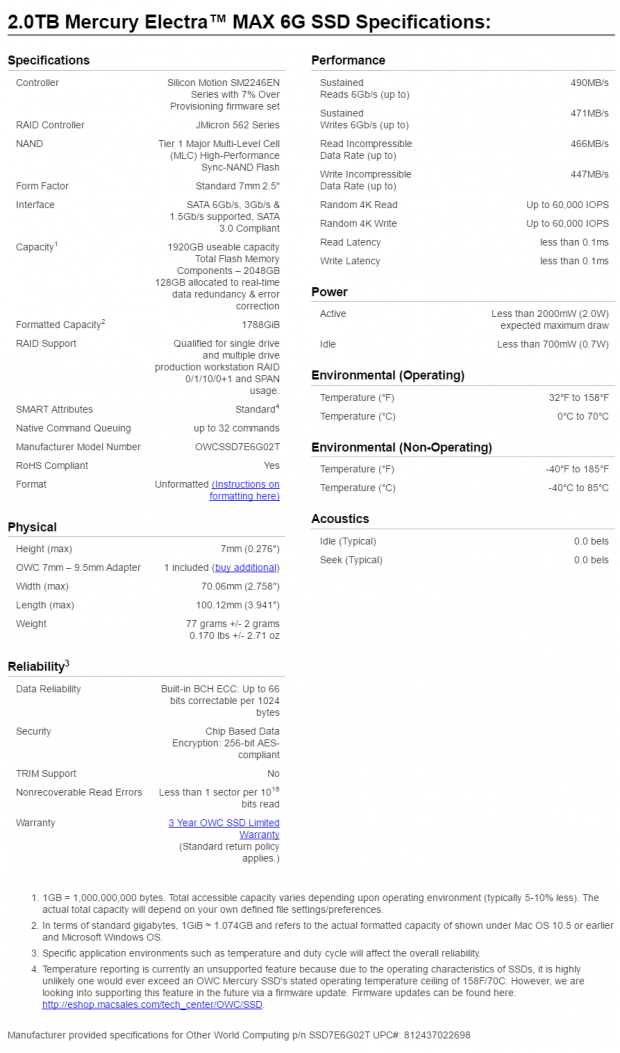
The OWC Mercury Electra MAX 6G 2TB SSD is currently selling for $599 direct from MacSales.com. Sequential read/write performance is listed as up to 490/471 MB/s. Random 4K read/write performance is listed at up to 60,000 IOPS. OWC backs the drive with a limited three-year warranty, and no TBW is given or implied.
OWC states on the spec sheet that the NAND utilized is "Tier 1 Major Multi-Level Cell (MLC) High-Performance Sync-NAND Flash." However, on OWC's website, we also found a reference to the NAND utilized as "premium-quality tier-1 async NAND." The keyword here is "async" meaning lower performing asynchronous NAND.
Judging by the performance specifications listed, we believe the NAND flash utilized is 16nm Micron asynchronous. Power consumption is listed as less than 2.0W active, 0.7W idle. TRIM is not supported, and although not listed, neither is secure erase. Capacity breaks down as follows: 1920GB useable capacity, Total Flash Memory Components - 2048GB, 128GB allocated to real-time data redundancy and error correction. Formatted capacity in Windows is 1788 GiB.
OWC states the following: "With exceptional wear-leveling and block management, gold-standard compression and data distribution, best-in-class error correction, intelligent recycling, and requiring no external TRIM support, the 2TB Mercury Electra MAX 6G SSD delivers incredible performance and dependability." We see this as OWC's explanation of why this drive does not need TRIM functionality. We, however, do not agree. TRIM functionality is so important that it is built-in to modern operating systems.
Drive Details
OWC Mercury Electra MAX 6G 2TB SATA III SSD
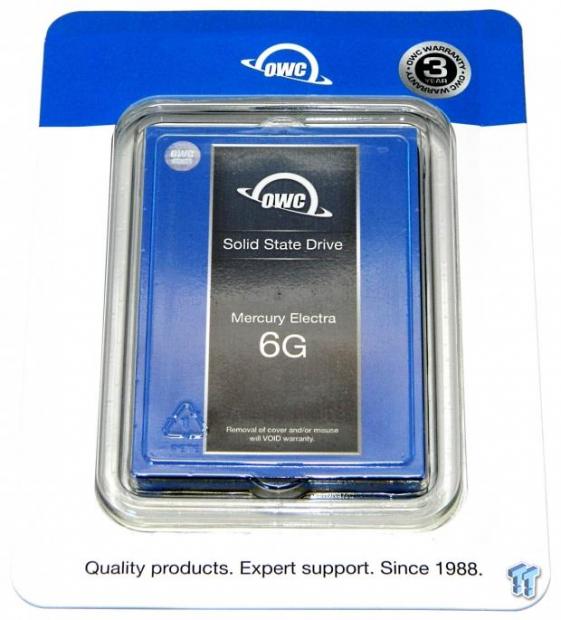
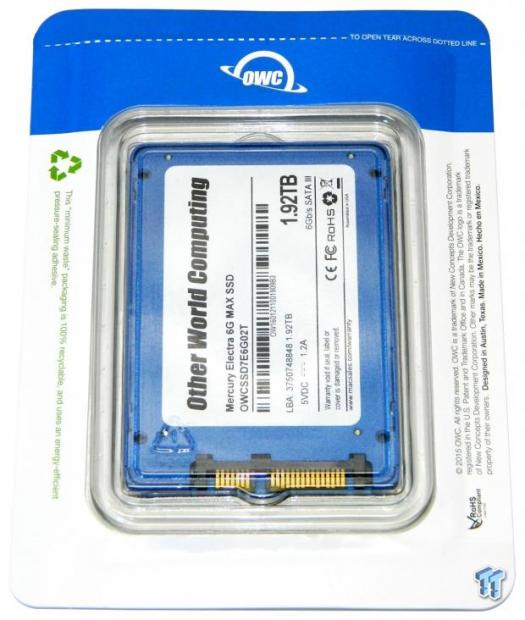
The Mercury Electra MAX 6G 2TB SATA III SSD ships in a simple blue and white blister pack. The drive itself is visible through the clear portion of the packaging. We note the capacity is listed at 1.92TB.
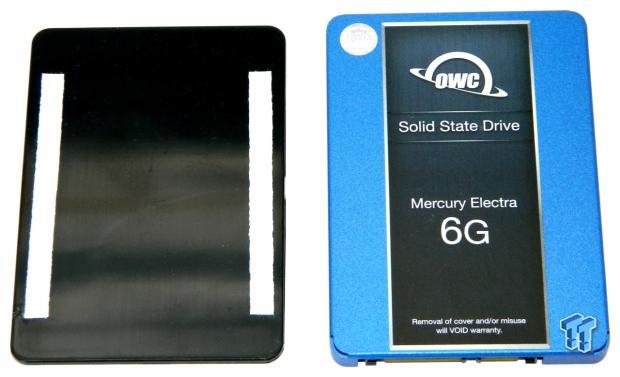
Inside the pack is the drive itself and a stick-on plastic spacer.
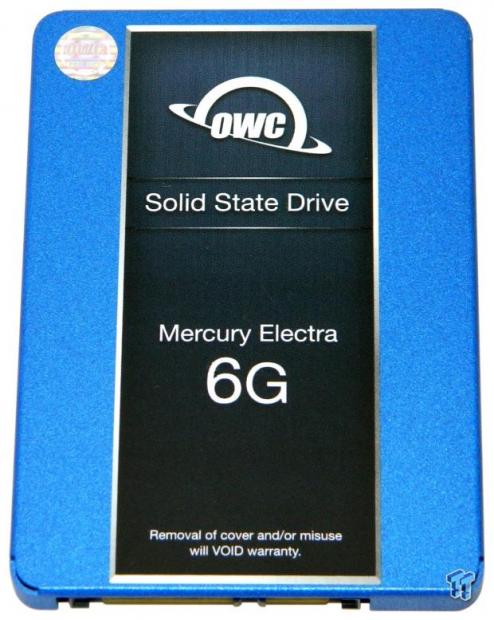
The top of the drives aluminum enclosure is painted blue. The look is minimalistic and attractive.
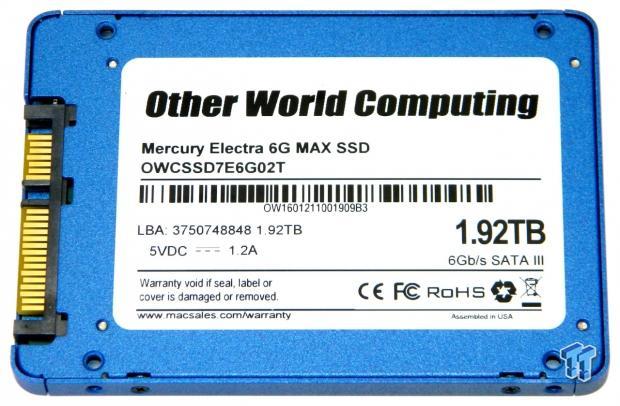
The back half of the drive's enclosure features a manufacturer's label listing the particulars of the drive.
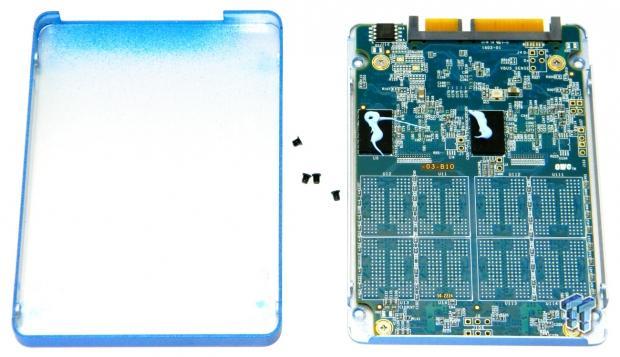
The PCB is secured to the bottom of the enclosure with four screws. We note the thermal paste blobbed onto the two 512MB DRAM chips that populate this side of the PCB.
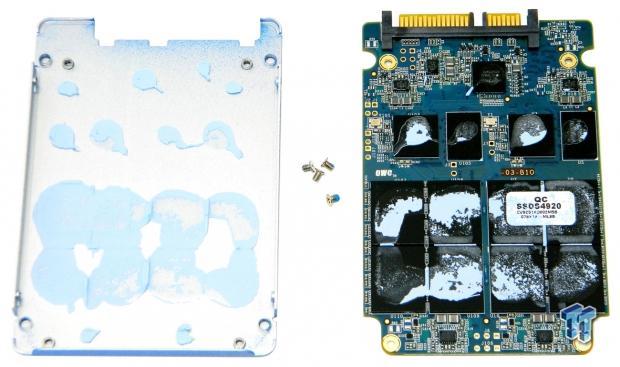
Removing the PCB from the enclosure reveals that all the major components on the PCB are covered with thermal paste. We cannot comment on the effectiveness of this unique thermal solution other than to say it's messy compared to the thermal pads we are familiar with.

This side of the PCB houses all eight of the drive's 256GB asynchronous 16nm MLC flash chips (large rectangular). Both of the drive's Silicon Motion SM2246EN 4-channel controllers (large square) are located on this side of the PCB. Two of the drive's four 512MB DDR3 DRAM cache packages (small rectangular) are located on this side of the PCB.
The JMicron 562 RAID controller chip (small square) that makes it tick is located on this side of the PCB as well. Normally we present close-in views of the major components of the drive, but not this time, because we don't want to deal with removing the thermal paste, which could compromise thermal dissipation.

This half of the PCB houses the remaining two 512MB DDR3 caching chips. We note that the drive's SATA and power connectors are integrated onto the PCB itself.
Test System Setup and Properties
Jon's Consumer SSD Review Test System Specifications
- Motherboard: ASRock Extreme9 Z97 - Buy from Amazon
- CPU: Intel Core i7 4790K @ 4.8GHz - Buy from Amazon / Read our review
- Cooler: Swiftech H2O-320 Edge - Buy from Amazon / Read our review
- Memory: Corsair Dominator DDR3 32GB 2400MHz - Buy from Amazon
- Video Card: Onboard Video
- Case: IN WIN X-Frame - Buy from Amazon / Read our review
- Power Supply: Seasonic Platinum 1000 Watt Modular - Buy from Amazon / Read our review
- OS: Microsoft Windows 10 Professional 64-bit - Buy from Amazon
- Drivers: Intel RAID option ROM version 13.0.0.2075 and Intel RST driver version 13.6.0.1002
We would like to thank ASRock, Crucial, Intel, Corsair, RamCity, IN WIN, and Seasonic for making our test system possible.
Drive Properties
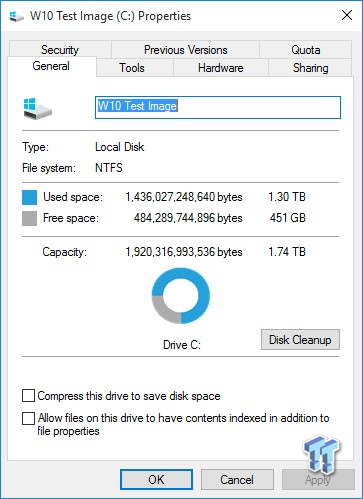
The majority of our testing is performed with our test drive as our boot volume. Our boot volume is 75% full for all OS Disk "C" drive testing to replicate a typical consumer OS volume implementation. We feel that most of you will be utilizing your SSDs for your boot volume and that presenting you with results from an OS volume is more relevant than presenting you with empty secondary volume results.
System settings: Cstates and Speed stepping are both disabled in our systems BIOS. Windows High-Performance power plan is enabled. Windows write caching is enabled, and Windows buffer flushing is disabled. We are utilizing Windows 10 Pro 64-bit OS for all of our testing except for our MOP (Maxed-Out Performance) benchmarks where we switch to Windows Server 2008 R2 64-bit.
In choosing our test pool, we chose the 2TB 850 Pro and EVO because they are the same capacity and direct competitors. We chose the Reactor and the TeraNova because they are both SM2246EN controlled drives with MLC flash. We chose the BX200 because it delivers sub-par performance and we want to compare it with OWC's Mercury Electra MAX 6G 2TB.
Synthetic Benchmarks - ATTO & Anvil Storage Utilities
ATTO
Version and / or Patch Used: 3.05
ATTO is a timeless benchmark used to provide manufacturers with data used for marketing storage products.
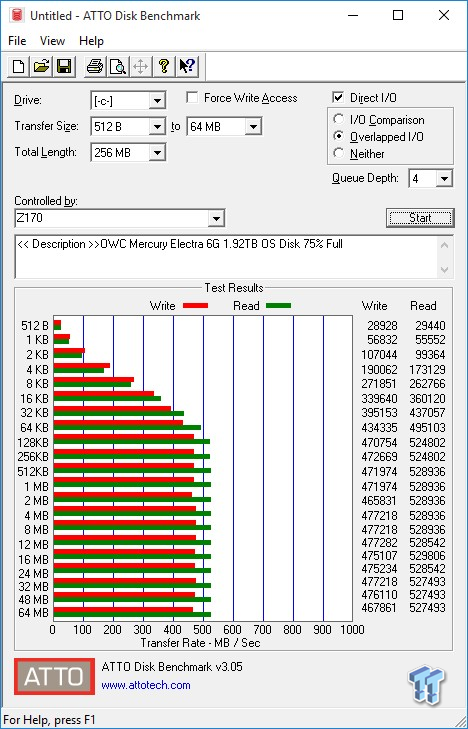
Compressible sequential read/write transfers max out at 529/477 MB/s. Keep in mind this is our OS volume, and it is filled to 75% of its total capacity. These figures are both higher than OWC's stated performance figures, but that's because those given by OWC are for sustained (steady-state) performance.
Sequential Write
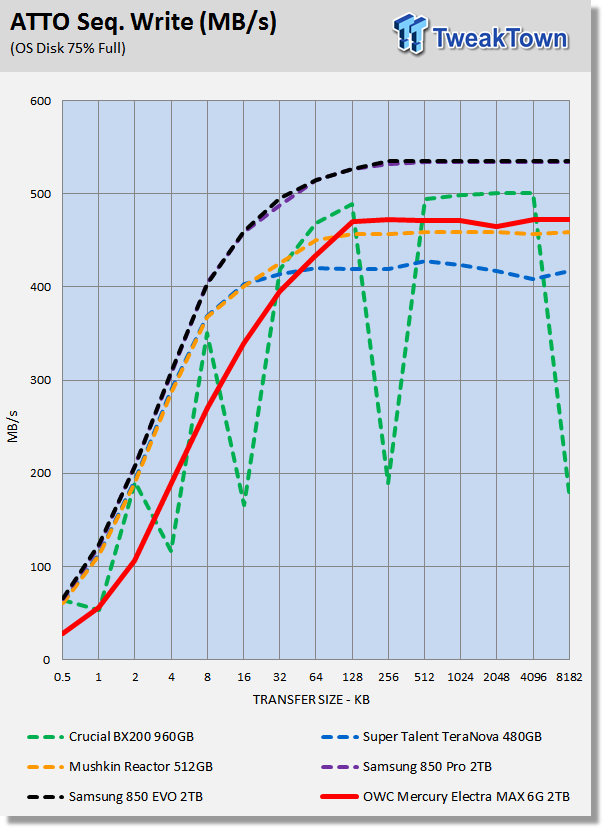
The Samsung drives win this test. The Reactor and TeraNova both deliver better small file write performance up to 32K than the OWC Mercury Electra MAX 6G 2TB or "Electra Max" as we will refer to it going forward.
Sequential Read
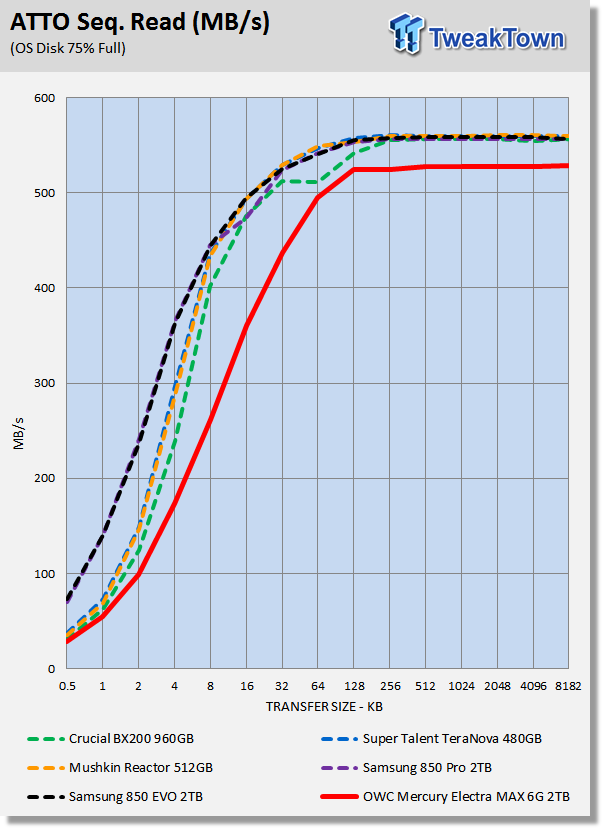
The Electra Max lags behind the rest of our test pool from start to finish. The Reactor and TeraNova are both SM2246EN powered drives with MLC flash, and they both handily outperform the Electra Max. This is exactly what we saw at CES, standard (meaning one controller) SM2246EN powered SSDs handily outperform the dual controller configuration that is the Electra Max.
Anvil Storage Utilities
Version and / or Patch Used: 1.1.0
Anvil's Storage Utilities is a storage benchmark designed to measure the storage performance of SSDs. The Standard Storage Benchmark performs a series of tests; you can run a full test or just the read or write test, or you can run a single test, i.e. 4k QD16.
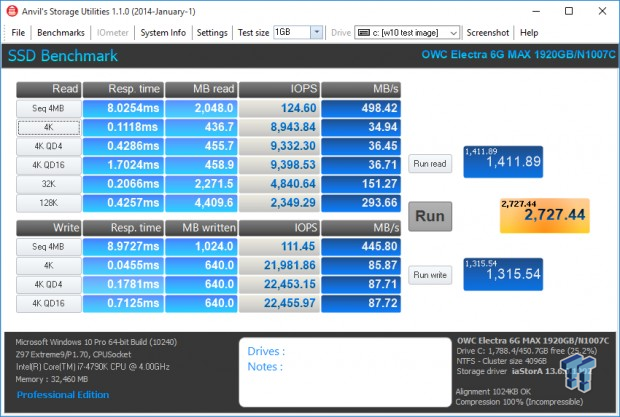
Scoring
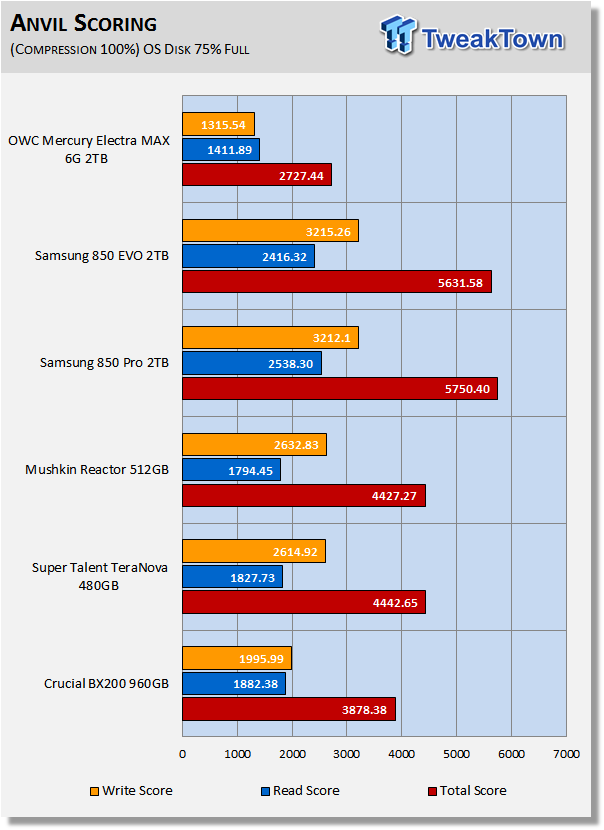
Anvil's scoring gives a good indication of a drive's overall performance. This score indicates that the Electra Max is at best, a sub-par performing SSD. Even the lowly BX200 eviscerates the Electra Max.
(Anvil) Read IOPS through Queue Depth Scale

This chart shows exactly why we chose our test pool the way we did. Samsung's 2TB drives are the best performing SATA SSDs on the market, both capable of delivering up to 10x the performance of OWC's Electra Max 2TB. We will point out that Samsung's 2TB 850 EVO is currently available for $604.
The Reactor and the TeraNova are both standard SM2246EN powered, and they are delivering up to 7x the performance of the Electra Max. The BX200 was up until now the worst performing recently released SSD on the market. All of this taken together goes back to the question we asked ourselves at CES; WHY? Why would anyone choose this path to more capacity? As we see it, bridging two good controllers with quite possibly the worst RAID controller on the market is not a good recipe.
(Anvil) Write IOPS through Queue Scale
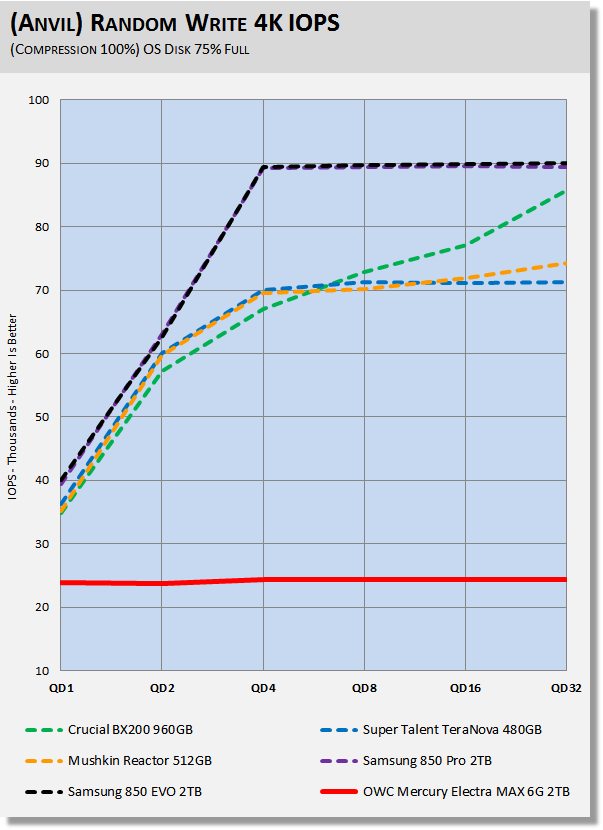
Write performance is no different. The Electra Max is again overmatched.
Synthetic Benchmarks - CrystalDiskMark & AS SSD
CrystalDiskMark
Version and / or Patch Used: 3.0 Technical Preview
CrystalDiskMark is disk benchmark software that allows us to benchmark 4k and 4k queue depths with accuracy. Note: Crystal Disk Mark 3.0 Technical Preview was used for these tests since it offers the ability to measure native command queuing at QD4.
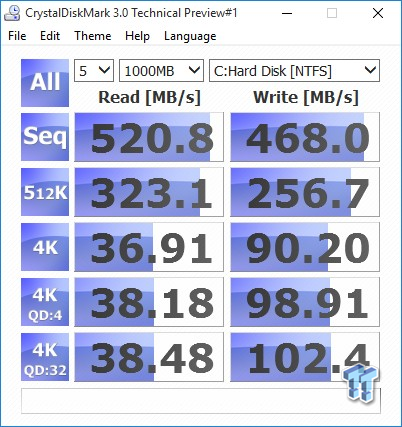
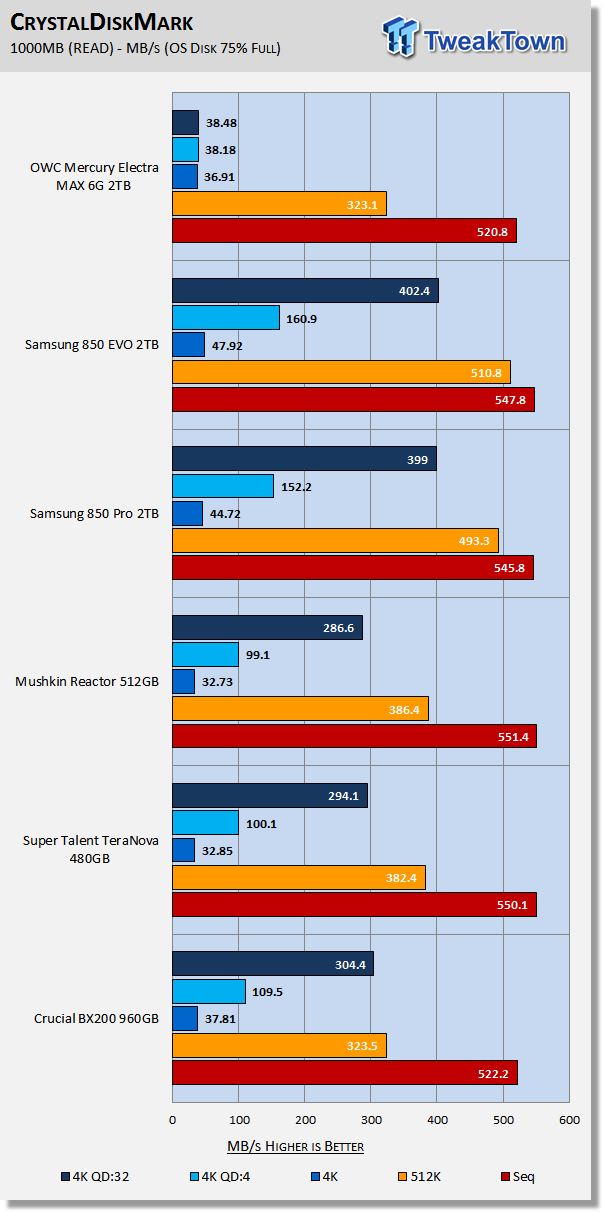
This backs up what we saw with Anvil's testing; the Electra Max's 4K random performance does not scale over QD1. The one bright spot for the Electra Max is 4K QD1 read performance that's significantly better than the Reactor and TeraNova.
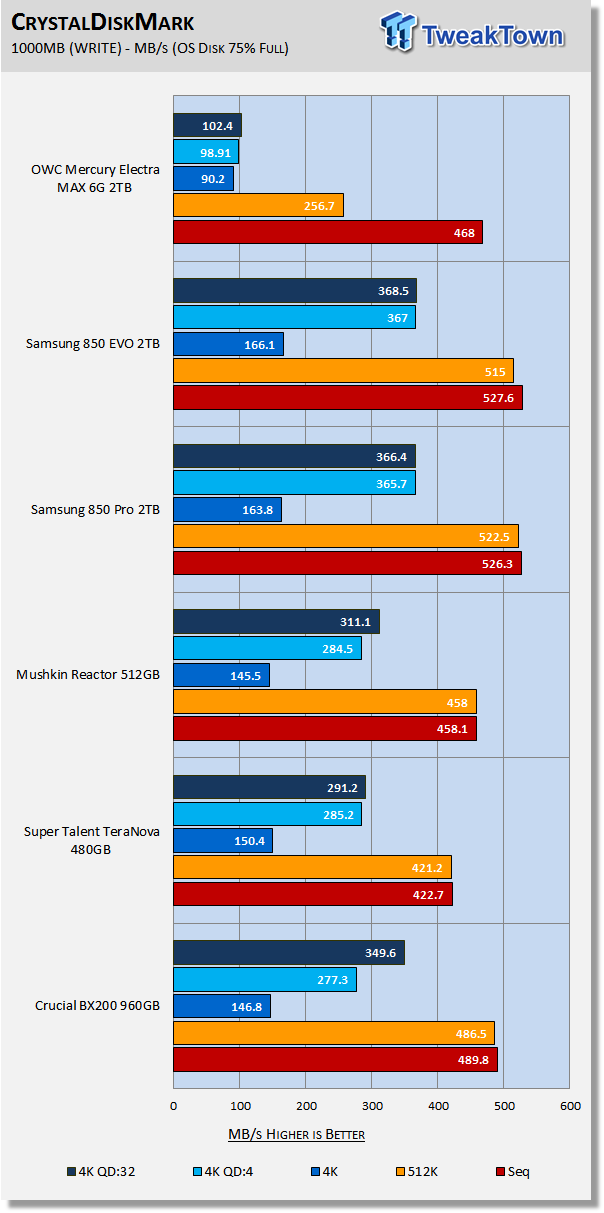
The Electra Max again has a lone bright spot; sequential write performance. The drive's sequential write performance is nowhere near that of the Samsung SSDs, but it is better than the standard SM2246EN powered drives in our test pool. Again, we observe no scaling past QD1.
AS SSD
Version and / or Patch Used: 1.7.4739.38088
AS SSD determines the performance of SSDs. The tool contains four synthetic as well as three practice tests. The synthetic tests are to determine the sequential and random read and write performance of the SSD.
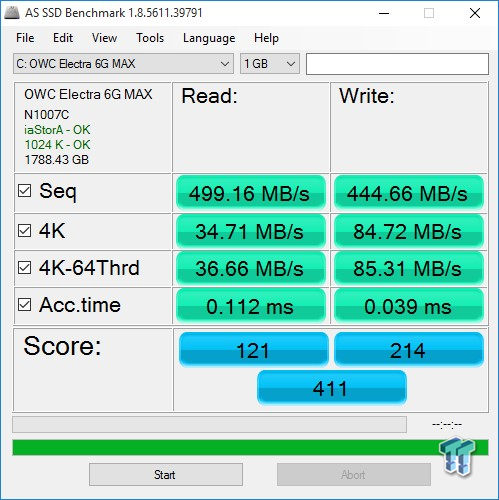
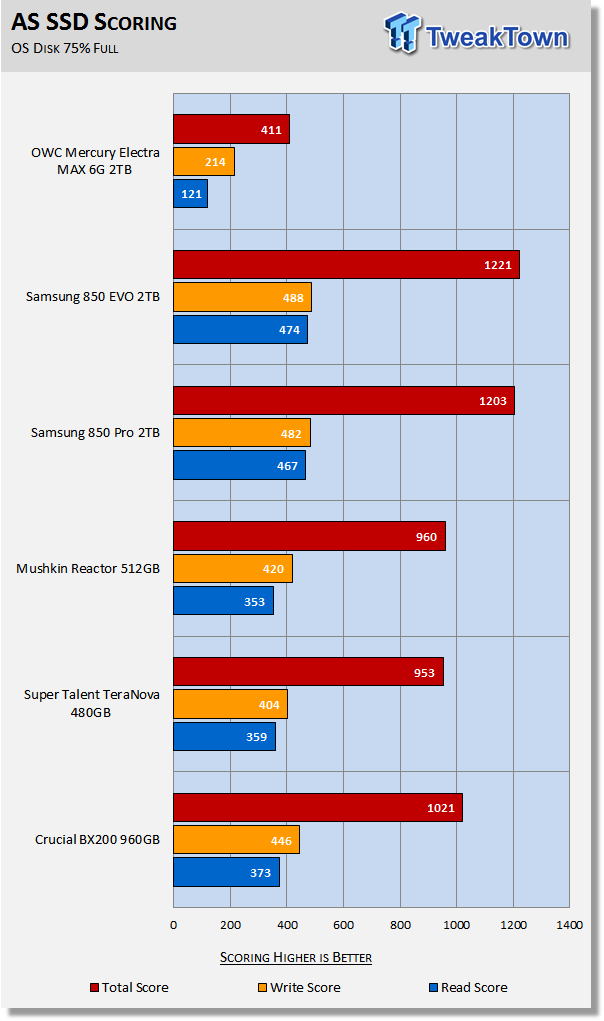
AS SSD is a demanding test, and the Electra Max is obliterated by it. Our synthetic benchmarks have not been kind to the Electra Max. Let's see if the Electra Max can do better with our moderate workload testing.
Benchmarks (Trace-Based OS Volume) - PCMark Vantage, PCMark 7 & PCMark 8
Moderate Workload Model
We categorize these tests as indicative of a moderate workload environment.
PCMark Vantage - Hard Disk Tests
Version and / or Patch Used: 1.2.0.0
The reason we like PCMark Vantage is because the recorded traces are played back without system stops. What we see is the raw performance of the drive. This allows us to see a marked difference between scoring that other trace-based benchmarks do not exhibit. An example of a marked difference in scoring on the same drive would be empty vs. filled vs. steady state.
We run Vantage three ways. The first run is with the OS drive 75% full to simulate a lightly used OS volume filled with data to an amount we feel is common for most users. The second run is with the OS volume written into a "Steady State" utilizing SNIA's guidelines. Steady state testing simulates a drive's performance similar to that of a drive that been subjected to consumer workloads for extensive amounts of time. The third run is a Vantage HDD test with the test drive attached as an empty, lightly used secondary device.
OS Volume 75% Full - Lightly Used
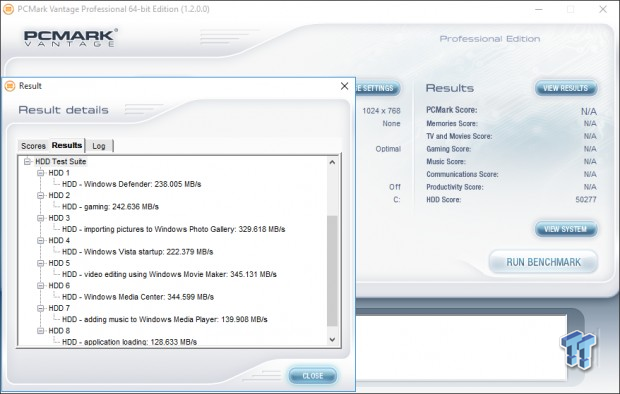
OS Volume 75% Full - Steady State

Secondary Volume Empty - FOB
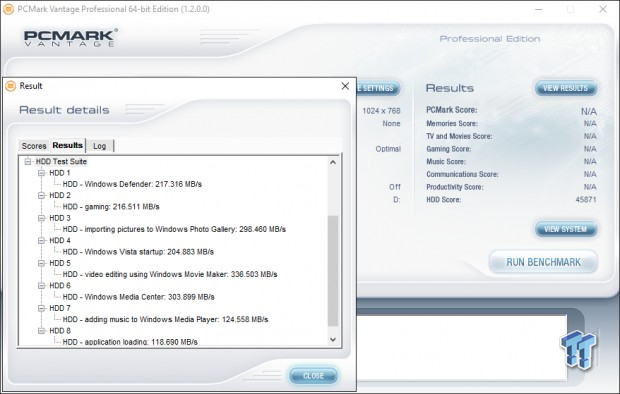
There's a big difference between an empty drive, one that's 75% full/used, and one that's in a steady state.
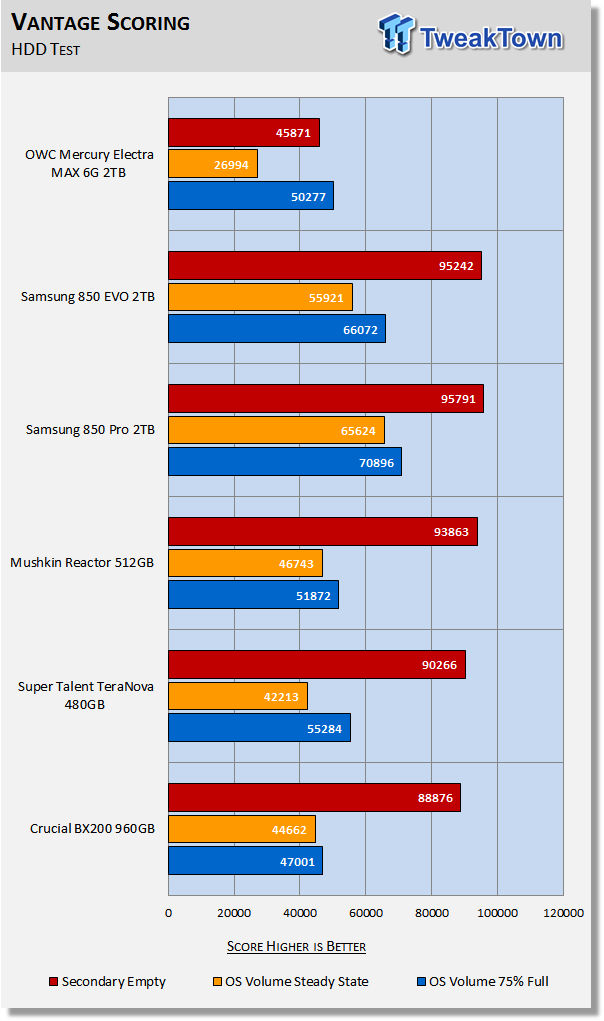
The important scores to pay attention to are "OS Volume Steady State" and "OS Volume 75% full." These two categories are most important because they are indicative of typical of consumer user states. When a drive is in a steady state, it means garbage collection is running at the same time it's reading/writing. This is exactly why we focus on steady state performance.
Initial real-world testing results are better for the Electra Max than what we saw from synthetic testing. However, when we look at the drive's steady-state performance, it's obvious that the drive's garbage collection is unable to keep up. We see a rather odd result in that the drive's 75% filled performance is better than its empty secondary performance. This is because the drive did not clean itself up even when cleaned with diskpart, formatted multiple times, and given an hour of idle time.
PCMark 7 - System Storage
Version and / or Patch Used: 1.4.0
We will look to Raw System Storage scoring for evaluation because it's done without system stops and, therefore, allows us to see significant scoring differences between drives.
OS Volume 75% Full - Lightly Used
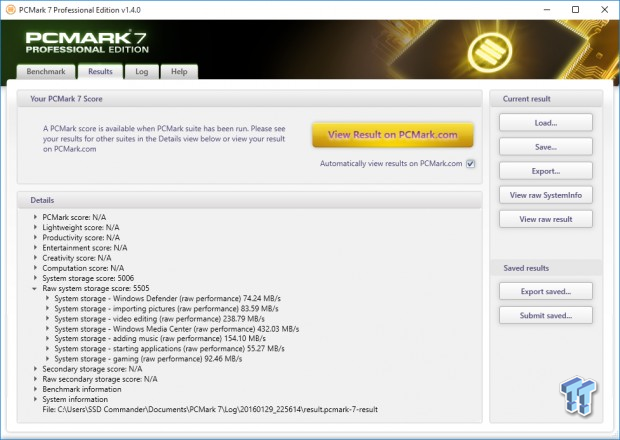
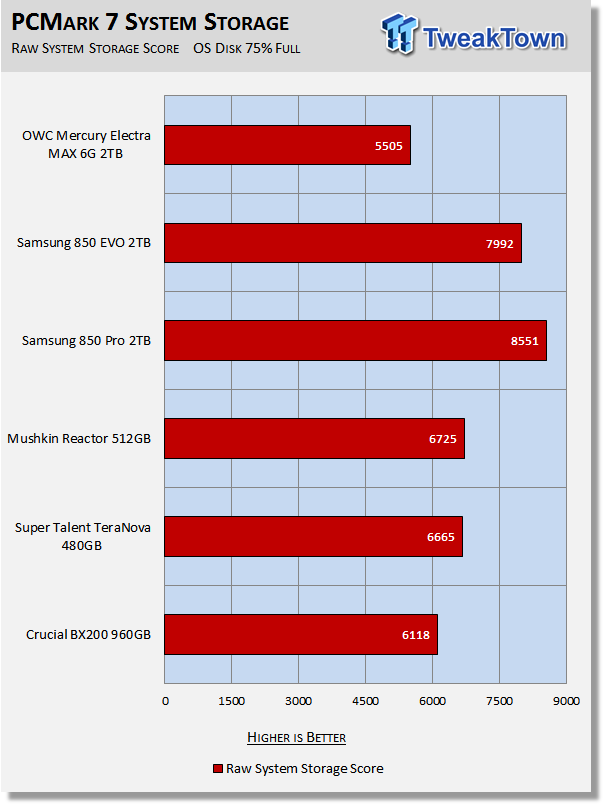
The Electra Max can muster a score that is not entirely embarrassing, but in comparison to the rest of our test pool, the Electra Max is significantly overmatched.
PCMark 8 - Storage Bandwidth
Version and / or Patch Used: 2.4.304
We use PCMark 8 Storage benchmark to test the performance of SSDs, HDDs, and hybrid drives with traces recorded from Adobe Creative Suite, Microsoft Office, and a selection of popular games. You can test the system drive or any other recognized storage device, including local external drives. Unlike synthetic storage tests, the PCMark 8 Storage benchmark highlights real-world performance differences between storage devices.
OS Volume 75% Full - Lightly Used
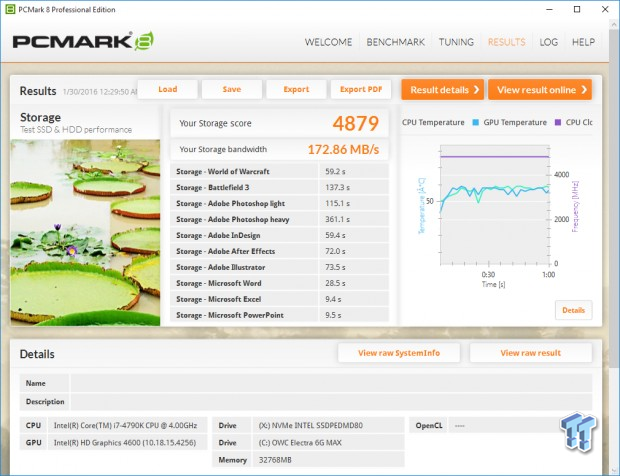
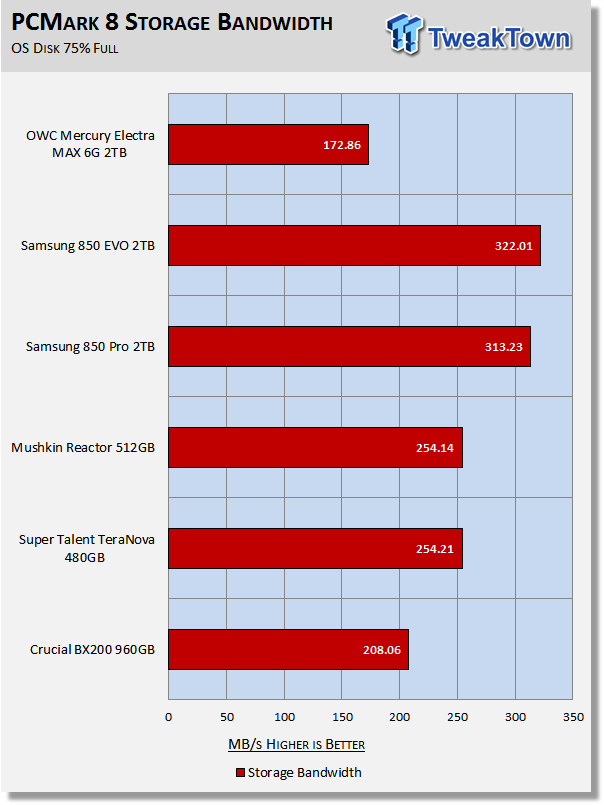
PCMark 8 is the most intensive moderate workload simulation we run. With respect to moderate workloads, this test is what we consider the best indicator of a drive's performance.
Synthetic testing was not kind to the Electra Max, and neither is our moderate workload testing. 172 MB/s storage bandwidth is by far the lowest bandwidth we've ever recorded with this test.
Benchmarks (Secondary Volume) – Max IOPS, Disk Response & Transfer Rates
Iometer – Maximum IOPS
Version and / or Patch Used: Iometer 2014
We use Iometer to measure high queue depth performance. (No Partition)
Max IOPS Read
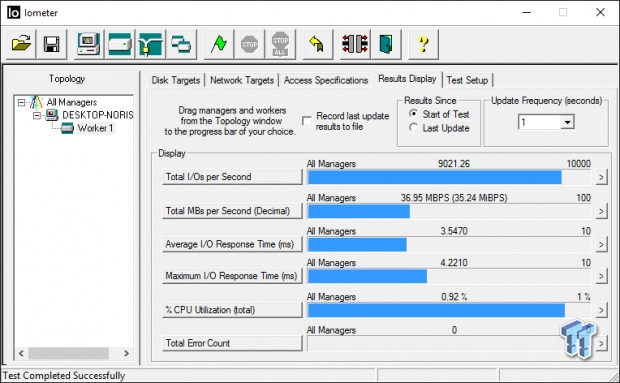
Max IOPS Write
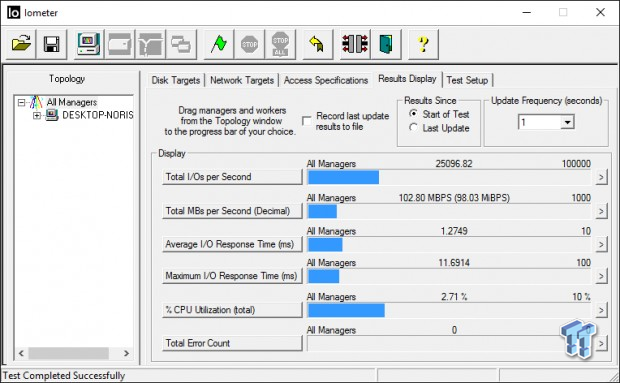

As we've seen all along, the Electra Max does not scale above QD1. One thing is for sure; there is no way this drive, with this firmware, is capable of hitting the 60K IOPS quoted on OWC's spec sheet.
Iometer – Disk Response
Version and / or Patch Used: Iometer 2014
We use Iometer to measure disk response times. Disk response times are measured at an industry accepted standard of 4K QD1 for both write and read. Each test runs twice for 30 seconds consecutively, with a 5-second ramp-up before each test. We partition the drive/array as a secondary device for this testing.
Avg. Write Response
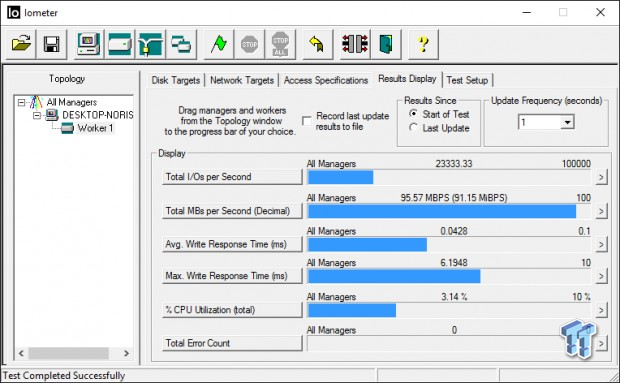
Avg. Read Response
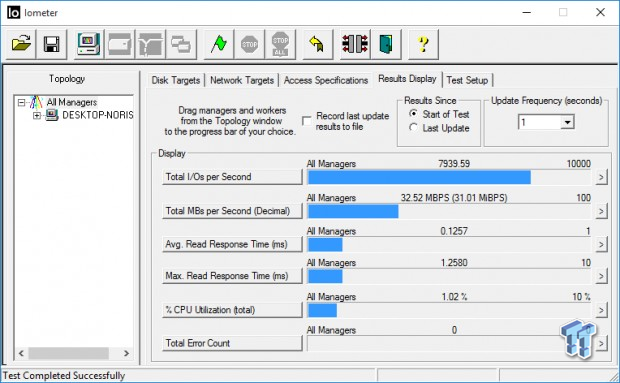
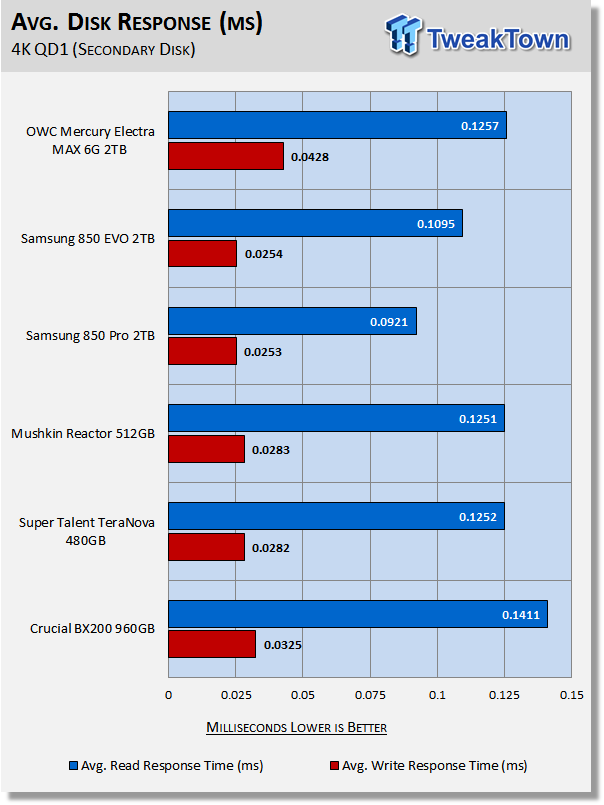
Read response is decent. Write response is terrible, in fact, its 51% higher than Mushkin's Reactor.
DiskBench - Directory Copy
Version and / or Patch Used: 2.6.2.0
We use DiskBench to time a 28.6GB block (9,882 files in 1,247 folders) composed primarily of incompressible sequential and random data as it's transferred from our DC P3700 PCIe NVME SSD to our test drive. We then read from a 6GB zip file that's part of our 28.6GB data block to determine the test drive's read transfer rate. Our system is restarted prior to the read test to clear any cached data, ensuring an accurate test result.
Write Transfer Rate
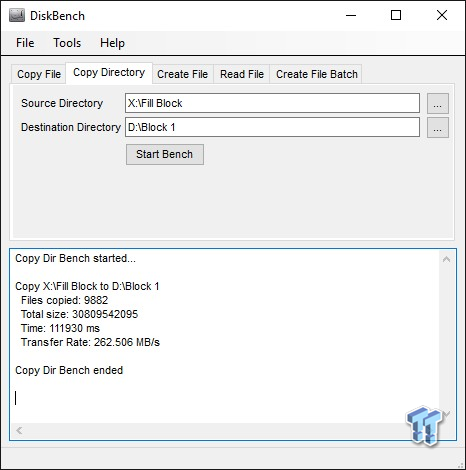
Read Transfer Rate
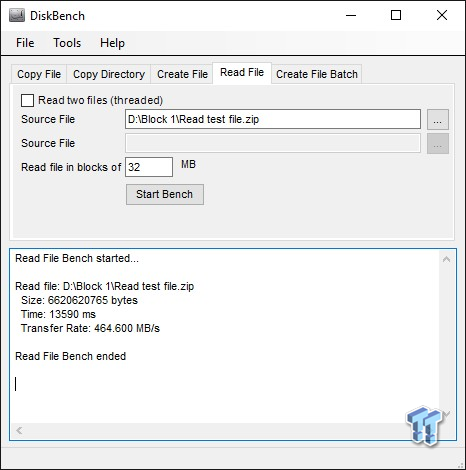
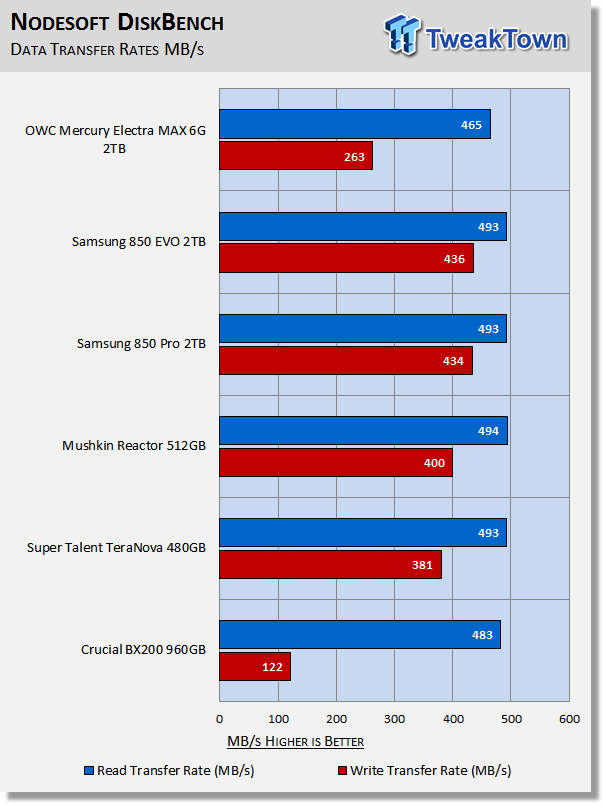
Read transfers are acceptable, but write transfer rates are terrible for an MLC-equipped SSD of this capacity. We believe that the lower performing asynchronous MLC flash array that populates the Electra Max is a contributing factor to its low write transfer rate.
Benchmarks (Secondary Volume) – PCMark 8 Extended
Futuremark PCMark 8 Extended
Heavy Workload Model
PCMark 8's consistency test simulates an extended duration heavy workload environment. PCMark 8 has built-in, command line executed storage testing. The PCMark 8 Consistency test measures the performance consistency and the degradation tendency of a storage system.
The Storage test workloads are repeated. Between each repetition, the storage system is bombarded with a usage that causes degraded drive performance. In the first part of the test, the cycle continues until a steady degraded level of performance has been reached. (Steady State)
In the second part, the recovery of the system is tested by allowing the system to idle and measuring the performance after 5-minute long intervals. (Internal drive maintenance: Garbage Collection (GC)) The test reports the performance level at the start, the degraded steady-state, and the recovered state, as well as the number of iterations required to reach the degraded state and the recovered state.
We feel Futuremark's Consistency Test is the best test ever devised to show the true performance of solid state storage in an extended duration heavy workload environment. This test takes on average 13 to 17 hours to complete and writes somewhere between 450GB and 14,000GB of test data depending on the drive. If you want to know what an SSDs steady state performance is going to look like during a heavy workload, this test will show you.
Here's a breakdown of Futuremark's Consistency Test:
Precondition phase:
1. Write to the drive sequentially through up to the reported capacity with random data.
2. Write the drive through a second time (to take care of overprovisioning).
Degradation phase:
1. Run writes of random size between 8*512 and 2048*512 bytes on random offsets for 10 minutes.
2. Run performance test (one pass only).
3. Repeat 1 and 2 for 8 times, and on each pass increase the duration of random writes by 5 minutes.
Steady state phase:
1. Run writes of random size between 8*512 and 2048*512 bytes on random offsets for 50 minutes.
2. Run performance test (one pass only).
3. Repeat 1 and 2 for 5 times.
Recovery phase:
1. Idle for 5 minutes.
2. Run performance test (one pass only).
3. Repeat 1 and 2 for 5 times.
Storage Bandwidth
PCMark 8's Consistency test provides a ton of data output that we use to judge a drive's performance.
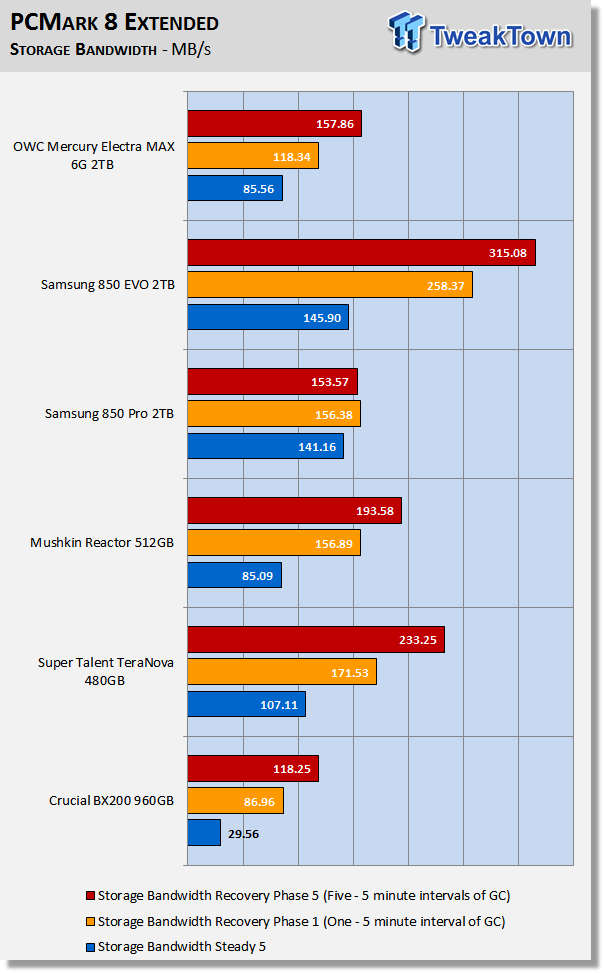
We consider steady state bandwidth (the blue bar) our test that carries the most weight in ranking a drive/arrays heavy workload performance. Performance after Garbage Collection (GC) (the orange and red bars) is what we consider the second most important consideration when ranking a drive's performance. Trace-based steady state testing is where true high performing SSDs are separated from the rest of the pack.
In a steady state, the Electra Max manages a somewhat respectable performance. We observe the drive does recover somewhat with idle intervals.
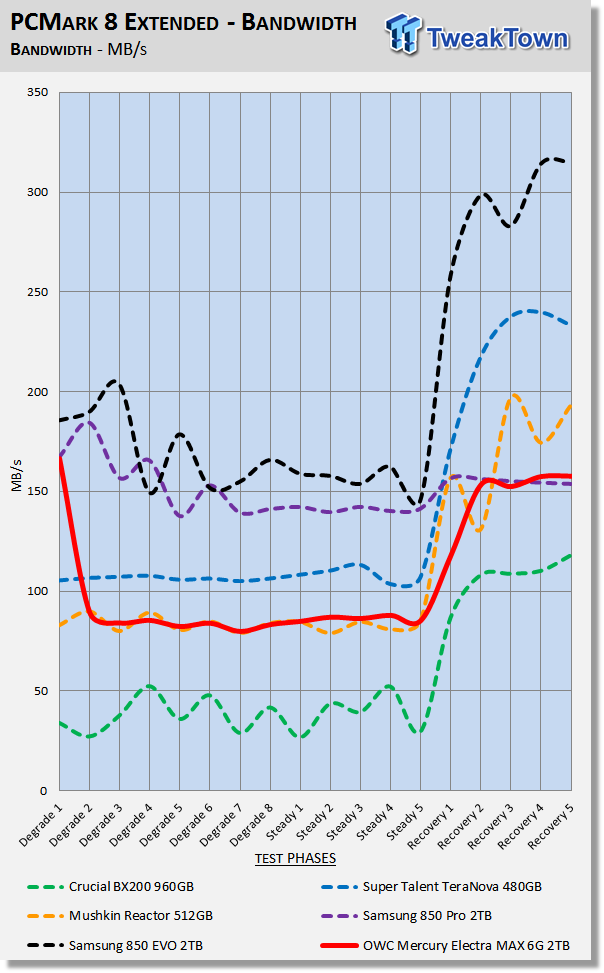
We chart our test subject's storage bandwidth as reported at each of the test's 18 trace iterations. This gives us a good visual perspective of how our test subjects perform as testing progresses. This chart sheds more light on how the drives perform as they progress through the testing phases.
Total Access Time (Latency)
We chart the total time the disk is accessed as reported at each of the test's 18 trace iterations.
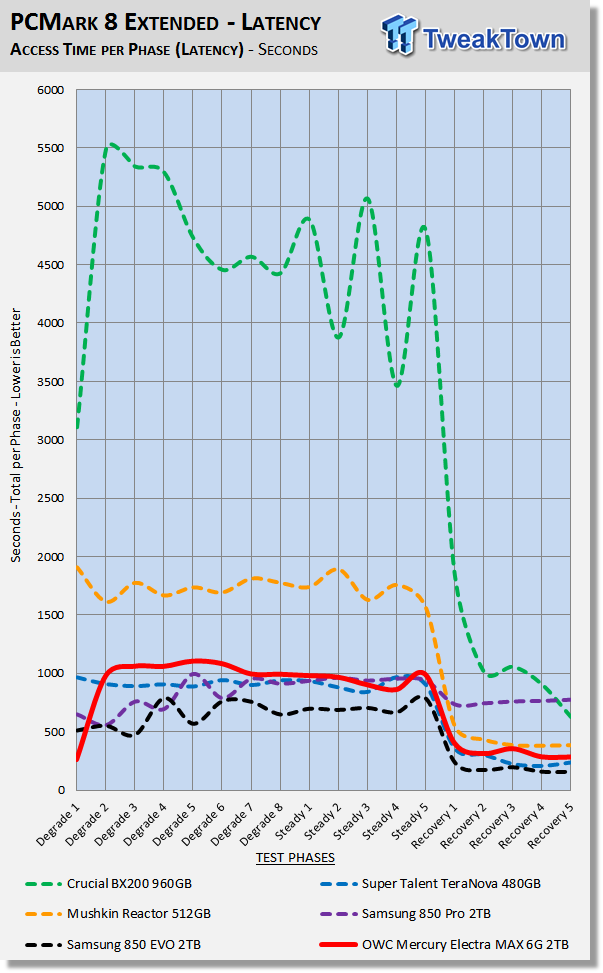
Disk Busy Time
Disk Busy Time is how long the disk is busy working. We chart the total time the disk is working as reported at each of the tests 18 trace iterations.
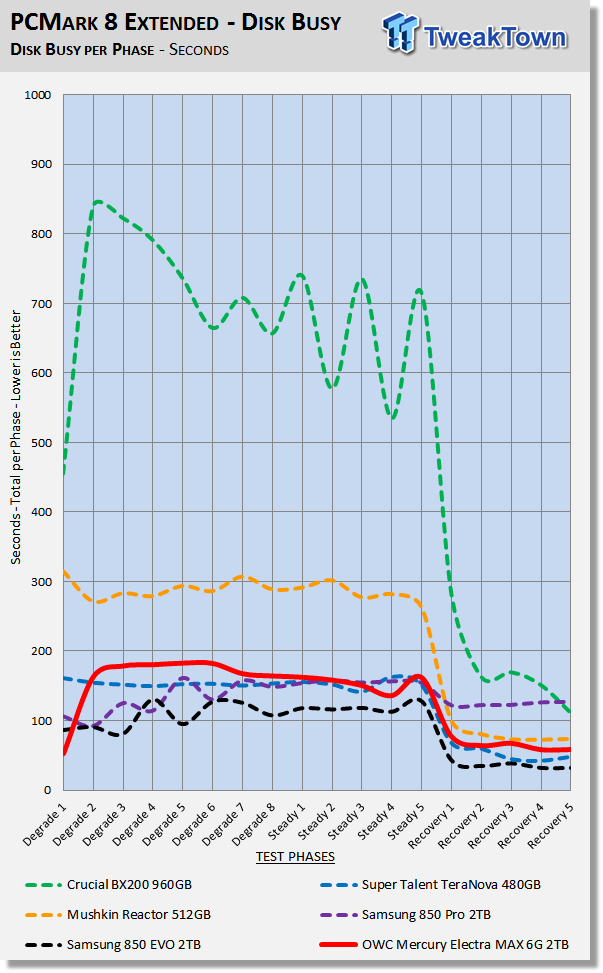
When latency is low, disk busy time is low as well.
Data Written
We measure the total amount of random data that our test drive/array is capable of writing during the degradation phases of the consistency test. Pre-conditioning data is not included in the total. The total combined time that degradation data is written to the drive/array is 470 minutes. This can be very telling. The better a drive/array can process a continuous stream of random data, the more data will be written.
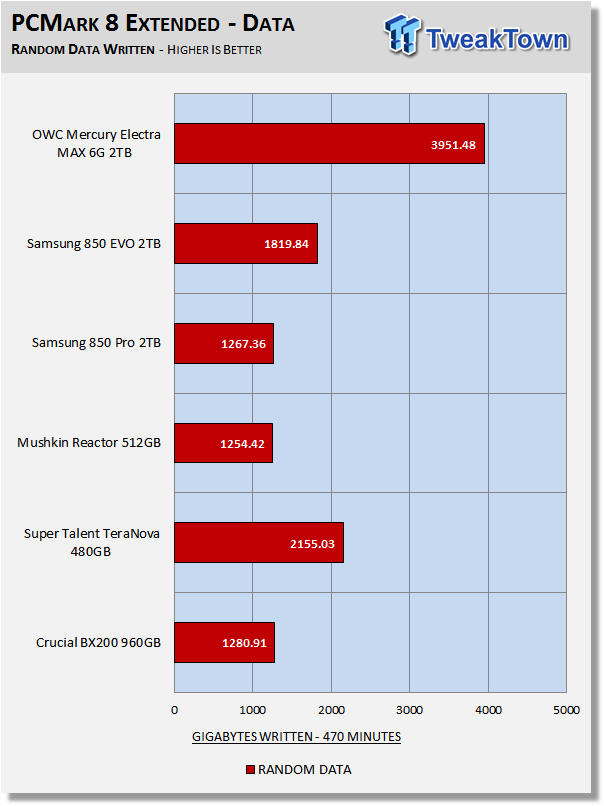
Combined write latency, capacity and overprovisioning are the biggest factors that determine the outcome of this portion of the test. This is a win for the Electra Max. The Electra Max is benefiting from over-provisioning as well as capacity and can write more random data than the rest of the drives in our test pool.
Benchmarks (Secondary Volume) – 70/30 Mixed Workload
70/30 Mixed Workload Test (Sledgehammer)
Version and / or Patch Used: Iometer 2014
Heavy Workload Model
This test hammers a drive so hard we've dubbed it "Sledgehammer". Our 70/30 Mixed Workload test is designed to simulate a heavy-duty enthusiast/workstation steady-state environment. We feel that a mix of 70% read/30% write, full random 4K transfers best represents this type of user environment. Our test allows us to see the drive enter into and reach a steady state as the test progresses.
Phase one of the test preconditions the drive for 1 hour with 128K sequential writes. Phase two of the test runs a 70% read/30% write, full random 4K transfer workload on the drive for 1 hour. We log and chart (phase two) IOPS data at 5-second intervals for 1 hour (720 data points). 60 data points = 5 minutes.
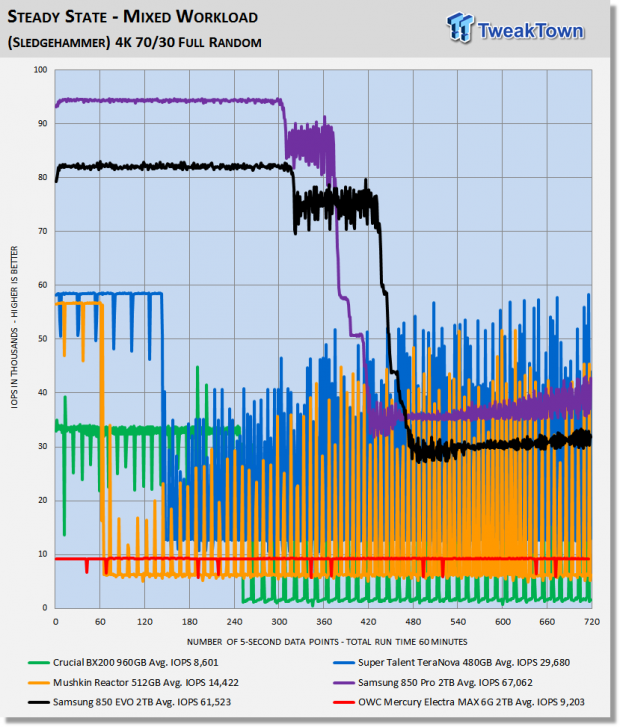
What we like about this test is that it reflects reality. Everything lines up, as it should. Consumer drives don't outperform Enterprise-Class SSDs that were designed for enterprise workloads. Consumer drives based on old technology are not outperforming modern Performance-Class SSDs, etc.
The Electra Max manages to outperform the BX200, but that's because the BX200 is a TLC-based SSD.
Maxed-Out Performance (MOP)
This testing is just to see what the drive is capable of in an FOB (Fresh Out of Box) state under optimal conditions. We are utilizing Windows Server 2008 R2 64-bit for this testing. Same Hardware, just an OS change.
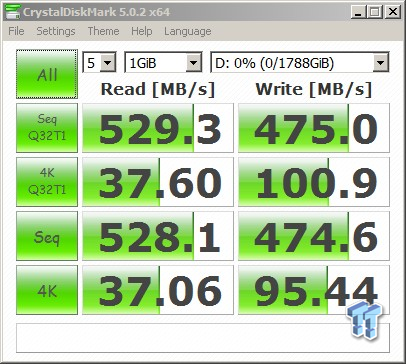
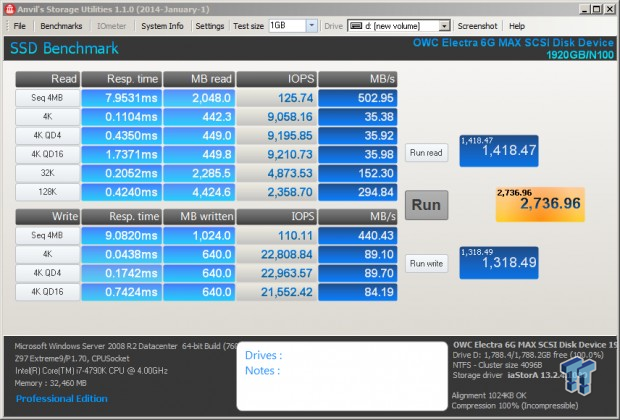
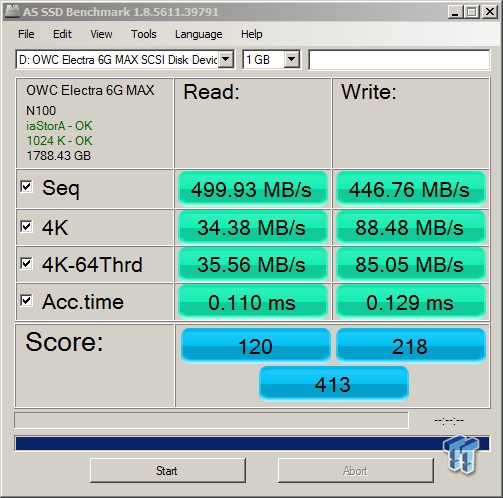
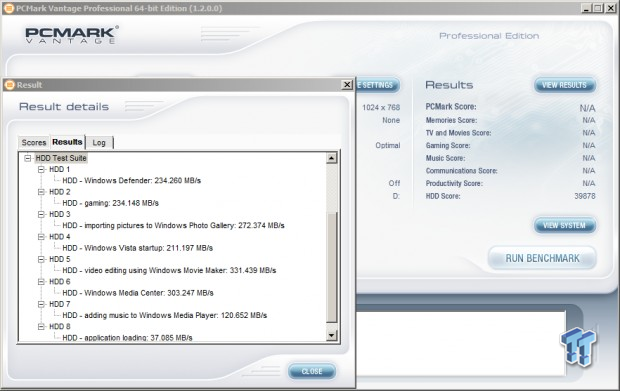
Usually our MOP results are far better than those run on our standard Windows 10 test suite. The Electra Max, however, does not regain performance because the drive is not TRIM capable, so formatting doesn't help.
Also, we were unable to Secure Erase the drive before running these benchmarks. We let the drive idle for an hour before running these benchmarks hoping that internal garbage collection would restore performance, sadly it did not. This would indicate to us that the drive, once it is in a steady state, does not recover as we have come to expect from today's SSDs.
Final Thoughts
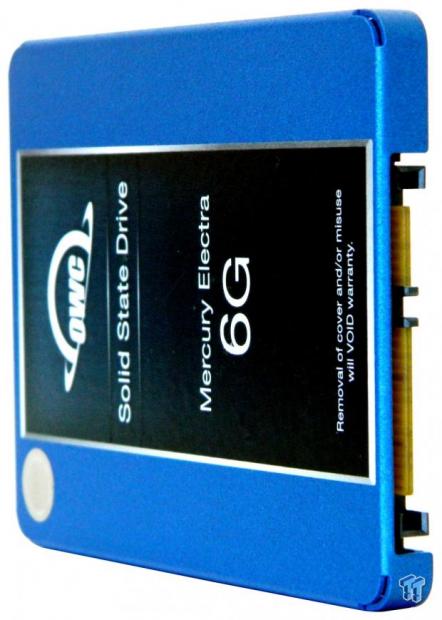
The OWC Mercury Electra Max 6G 2TB is a drive that we were excited to review. Over the years, OWC has delivered excellent performing SSDs, and we fully expected this SSD would be no different in that respect. That is until we saw the drive's spec sheet and we realized that the OWC Mercury Electra Max 6G 2TB was a dual SM2246EN controlled SSD with a JMicron RAID controller built-in. And to top it off, that "Tier 1 Major Multi-Level Cell (MLC) High-Performance Sync-NAND Flash" as quoted on the spec sheet, turns out to be lower performing asynchronous MLC flash.
Benchmarking the drive confirmed that this drive is one of the worst performing configurations we've ever seen. Until now, we regarded the BX200 as the worst performing recently introduced SSD, and that is to be expected because it is a TLC SSD equipped with the lowest performing flash on the market. From the moment we booted the Electra Max as our OS disk filled to 75% of its capacity, it was apparent that performance would be lackluster. We were hoping that after a few hours of idle time the drive would become more responsive, but it did not.
We are really at a loss trying to figure out how a drive of this configuration would ever seem like a good idea. OWC's Mercury Electra Max 6G 2TB SSD delivers the lowest overall performance of any SSD currently on the market. The drive has no TRIM support, no queue scaling, no secure erase support, and to top it off, it's priced similarly to Samsung's 850 EVO 2TB which is vastly superior in every aspect. We don't know if performance will be improved through a firmware update, but as it stands, we cannot recommend this SSD.
Pros:
- Attractive Enclosure
Cons:
- No TRIM Support
- Sub-Par Performance
- High MSRP

